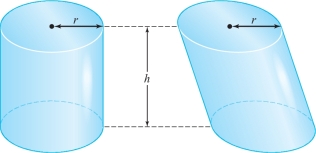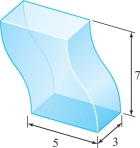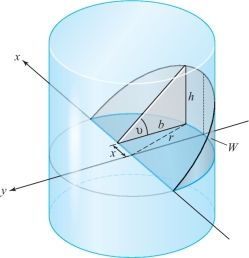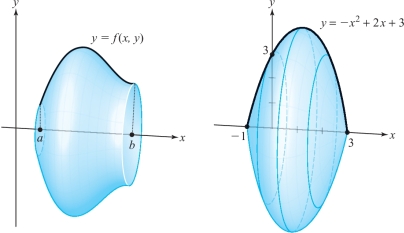Exercises for Section 15.1
Question 15.4
Evaluate the following iterated integrals:
- (a) \(\displaystyle\int_{0}^{1} \int_{0}^{1} ( 1 - x^3 + xy ) \, {\it dx}\, {\it dy}\)
- (b) \(\displaystyle\int_{0}^{\pi/2} \int_{-\pi/2}^{\pi/2} \cos x \sin y \, {\it dx}\, {\it dy}\)
- (c) \(\displaystyle\int_{1}^{2} \int_{2}^{4} \left( \frac{x}{y} + \frac{y}{x} \right) \, {\it dx}\, {\it dy}\)
- (d) \(\displaystyle\int_{0}^{\pi/4} \int_{0}^{\pi/4} \tan x \sec^{2} y \, {\it dx}\, {\it dy}\)
270
Question 15.5
Evaluate the integrals in the exercise above by integrating first with respect to \(y\) and then with respect to \(x\).
Question 15.6
Evaluate the following iterated integrals:
- (a) \(\displaystyle\int_{-1}^1\int_0^1(x^4y+y^2)\, {\it dy}\,{\it dx}\)
- (b) \(\displaystyle\int_0^{\pi/2}\int_0^1(\,y\cos x+2)\, {\it dy}\,{\it dx}\)
- (c) \(\displaystyle\int_0^1\int_0^1(xye^{x+y})\, {\it dy}\,{\it dx}\)
- (d) \(\displaystyle\int_{-1}^0\int_1^2(-x\log y)\, {\it dy}\,{\it dx}\)
Question 15.7
Evaluate the integrals in the third exercise by integrating with respect to \(x\) and then with respect to \(y\). [The solution to part (b) only is in the Study Guide to this text.]
Question 15.8
Use Cavalieri’s principle to show that the volumes of two cylinders with the same base and height are equal (see Figure 15.10).

Question 15.9
Using Cavalieri’s principle, compute the volume of the structure shown in Figure 15.11; each cross section is a rectangle of length 5 and width 3.

Question 15.10
A lumberjack cuts out a wedge-shaped piece \(W\) of a cylindrical tree of radius \(r\) obtained by making two saw cuts to the tree’s center, one horizontally and one at an angle \(\theta\). Compute the volume of the wedge \(W\) using Cavalieri’s principle. (See Figure 15.12.)

Question 15.11
- (a) Show that the volume of the solid of revolution shown in Figure 15.13 is \[ \pi \int_a^b \, [f(x)]^2\, {\it dx} . \]
- (b) Show that the volume of the region obtained by rotating the region under the graph of the parabola \(y= -x^2+2x+3\), \(-1\leq x\leq 3\), about the \(x\) axis is \(512\pi/15\) [see Figure 15.13].

271
Evaluate the double integrals in the next three exercises, where R is the rectangle \([0,2]\times [-1,0]\).
Question 15.12
\(\displaystyle \intop\!\!\!\intop\nolimits_{R}\, (x^2y^2+x)\, {\it dy}\,{\it dx}\)
Question 15.13
\(\displaystyle \intop\!\!\!\intop\nolimits_{R} \left(|y|\cos\frac{1}{4}\pi x\right) {\it dy}\,{\it dx}\)
Question 15.14
\(\displaystyle \intop\!\!\!\intop\nolimits_{R} \left({-}xe^x\sin\frac{1}{2}\pi y\right) {\it dy}\,{\it dx}\)
Question 15.15
Evaluate the iterated integral: \[ \int_{1}^{3} \int_{1}^{2} \frac{xy}{\left( x^2 + y^2 \right)^{3/2}} \, {\it dx}\, {\it dy}. \]
Question 15.16
Evaluate the iterated integral: \[ \int_{0}^{1} \int_{0}^{1} \left( 3x + 2y \right)^{7} \, {\it dx}\, {\it dy}. \]
Question 15.17
Find the volume bounded by the graph of \(f(x,y)=1+2x+3y\), the rectangle \([1,2]\times [0,1]\), and the four vertical sides of the rectangle \(R\), as in Figure 15.1.
Question 15.18
Repeat the previous exercise for the function \(f(x,y) = x^4 + y^2\) and the rectangle \([-1,1]\times [-3,-2]\).